Cryptocurrency: Ethics and Social Issues Report - COIT1123
VerifiedAdded on 2020/05/16
|10
|2407
|477
Report
AI Summary
This report provides a comprehensive overview of cryptocurrency, delving into its foundational aspects and exploring various ethical and social issues. It begins with an introduction to cryptocurrency as a digital asset secured by cryptography, contrasting it with traditional financial systems. The report then outlines the technology's background, including its use of blockchain and tokens. A significant portion is dedicated to identifying stakeholders, such as academics, industry groups, customers, and miners. Intellectual property issues, including patents, trademarks, and copyrights within the cryptocurrency space, are examined. The report further explores the opportunities and benefits of cryptocurrency, such as immediate settlements and lower fees, while also addressing associated risks, including cybercrime, privacy concerns, and investment volatility. The report concludes with a summary of the key findings and references supporting literature.
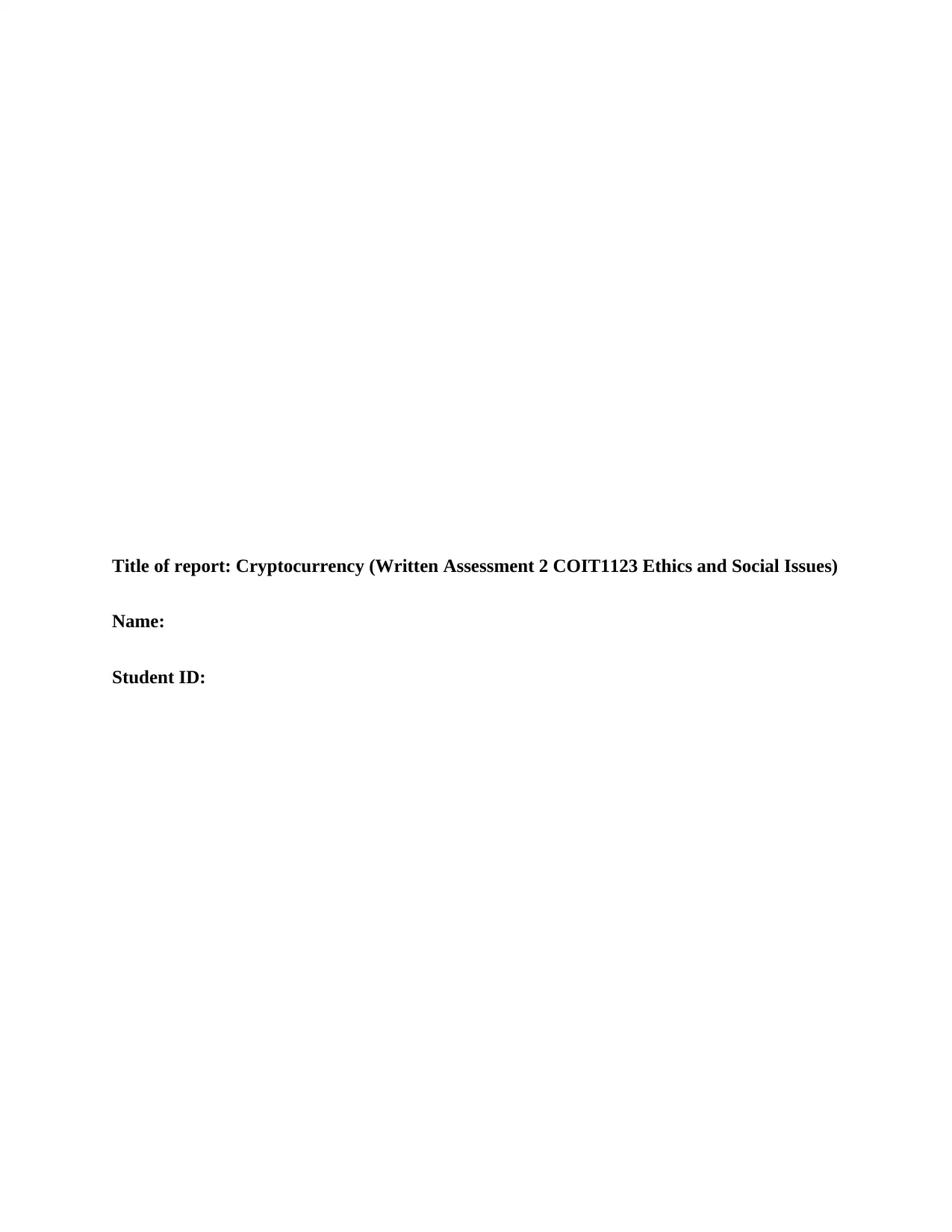
Title of report: Cryptocurrency (Written Assessment 2 COIT1123 Ethics and Social Issues)
Name:
Student ID:
Name:
Student ID:
Paraphrase This Document
Need a fresh take? Get an instant paraphrase of this document with our AI Paraphraser
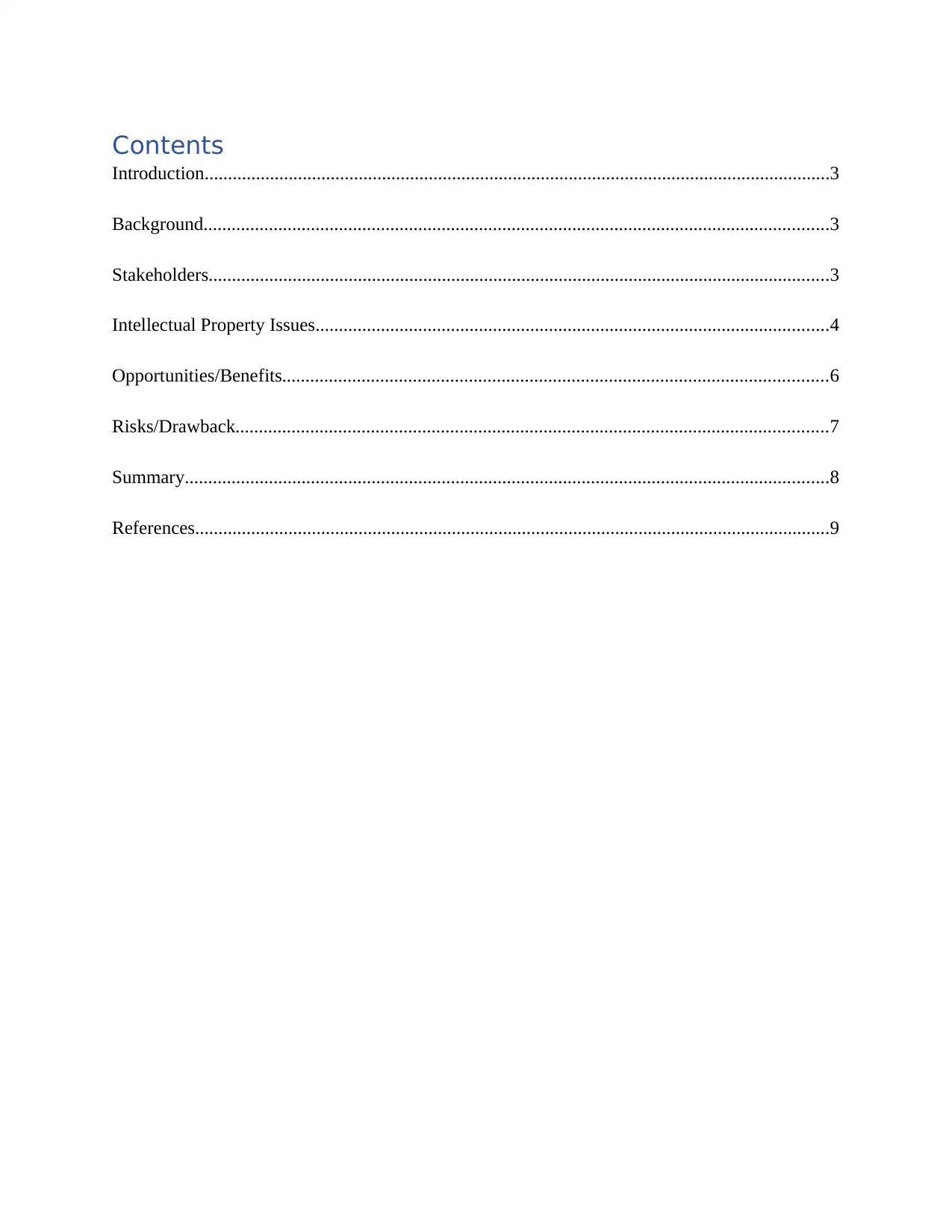
Contents
Introduction......................................................................................................................................3
Background......................................................................................................................................3
Stakeholders.....................................................................................................................................3
Intellectual Property Issues..............................................................................................................4
Opportunities/Benefits.....................................................................................................................6
Risks/Drawback...............................................................................................................................7
Summary..........................................................................................................................................8
References........................................................................................................................................9
Introduction......................................................................................................................................3
Background......................................................................................................................................3
Stakeholders.....................................................................................................................................3
Intellectual Property Issues..............................................................................................................4
Opportunities/Benefits.....................................................................................................................6
Risks/Drawback...............................................................................................................................7
Summary..........................................................................................................................................8
References........................................................................................................................................9
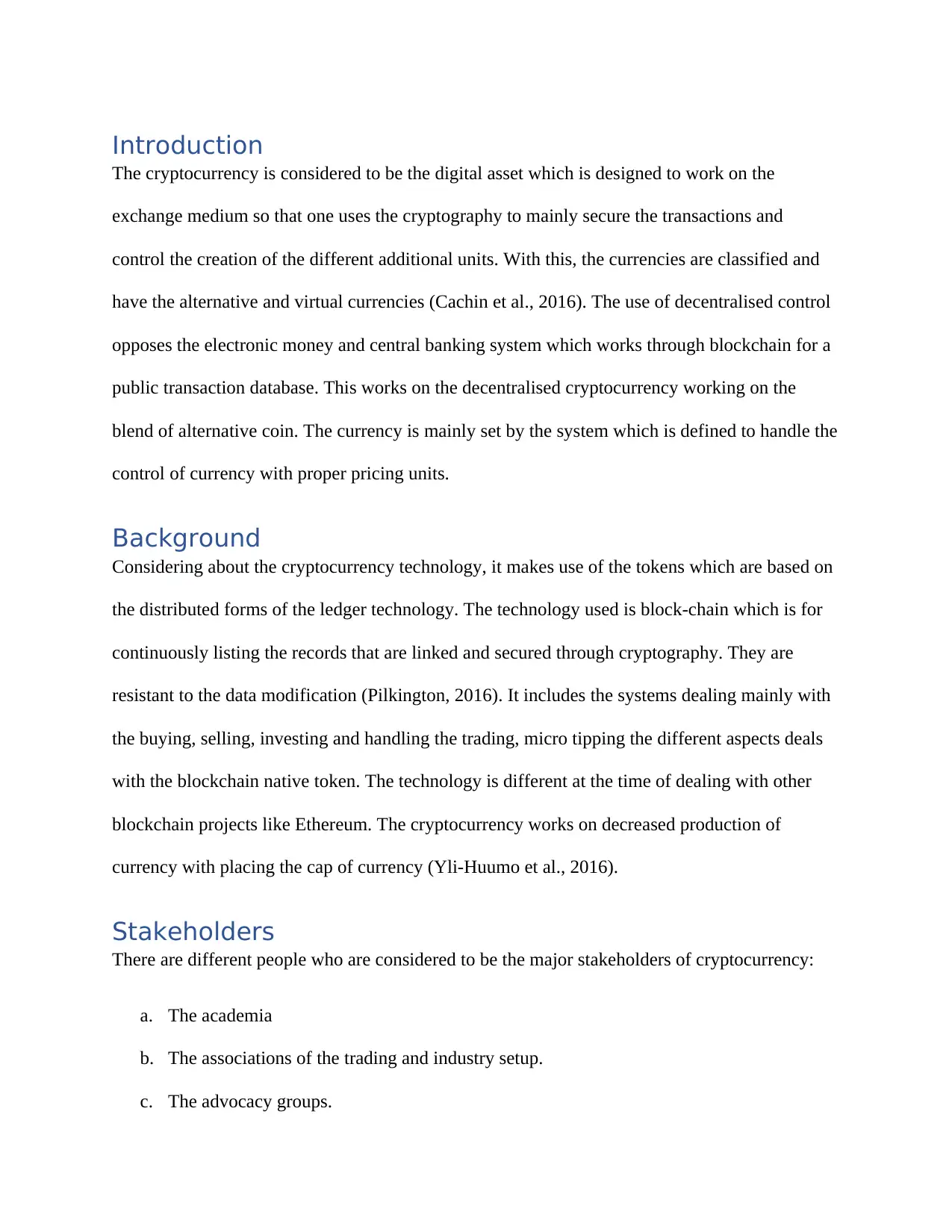
Introduction
The cryptocurrency is considered to be the digital asset which is designed to work on the
exchange medium so that one uses the cryptography to mainly secure the transactions and
control the creation of the different additional units. With this, the currencies are classified and
have the alternative and virtual currencies (Cachin et al., 2016). The use of decentralised control
opposes the electronic money and central banking system which works through blockchain for a
public transaction database. This works on the decentralised cryptocurrency working on the
blend of alternative coin. The currency is mainly set by the system which is defined to handle the
control of currency with proper pricing units.
Background
Considering about the cryptocurrency technology, it makes use of the tokens which are based on
the distributed forms of the ledger technology. The technology used is block-chain which is for
continuously listing the records that are linked and secured through cryptography. They are
resistant to the data modification (Pilkington, 2016). It includes the systems dealing mainly with
the buying, selling, investing and handling the trading, micro tipping the different aspects deals
with the blockchain native token. The technology is different at the time of dealing with other
blockchain projects like Ethereum. The cryptocurrency works on decreased production of
currency with placing the cap of currency (Yli-Huumo et al., 2016).
Stakeholders
There are different people who are considered to be the major stakeholders of cryptocurrency:
a. The academia
b. The associations of the trading and industry setup.
c. The advocacy groups.
The cryptocurrency is considered to be the digital asset which is designed to work on the
exchange medium so that one uses the cryptography to mainly secure the transactions and
control the creation of the different additional units. With this, the currencies are classified and
have the alternative and virtual currencies (Cachin et al., 2016). The use of decentralised control
opposes the electronic money and central banking system which works through blockchain for a
public transaction database. This works on the decentralised cryptocurrency working on the
blend of alternative coin. The currency is mainly set by the system which is defined to handle the
control of currency with proper pricing units.
Background
Considering about the cryptocurrency technology, it makes use of the tokens which are based on
the distributed forms of the ledger technology. The technology used is block-chain which is for
continuously listing the records that are linked and secured through cryptography. They are
resistant to the data modification (Pilkington, 2016). It includes the systems dealing mainly with
the buying, selling, investing and handling the trading, micro tipping the different aspects deals
with the blockchain native token. The technology is different at the time of dealing with other
blockchain projects like Ethereum. The cryptocurrency works on decreased production of
currency with placing the cap of currency (Yli-Huumo et al., 2016).
Stakeholders
There are different people who are considered to be the major stakeholders of cryptocurrency:
a. The academia
b. The associations of the trading and industry setup.
c. The advocacy groups.
⊘ This is a preview!⊘
Do you want full access?
Subscribe today to unlock all pages.

Trusted by 1+ million students worldwide
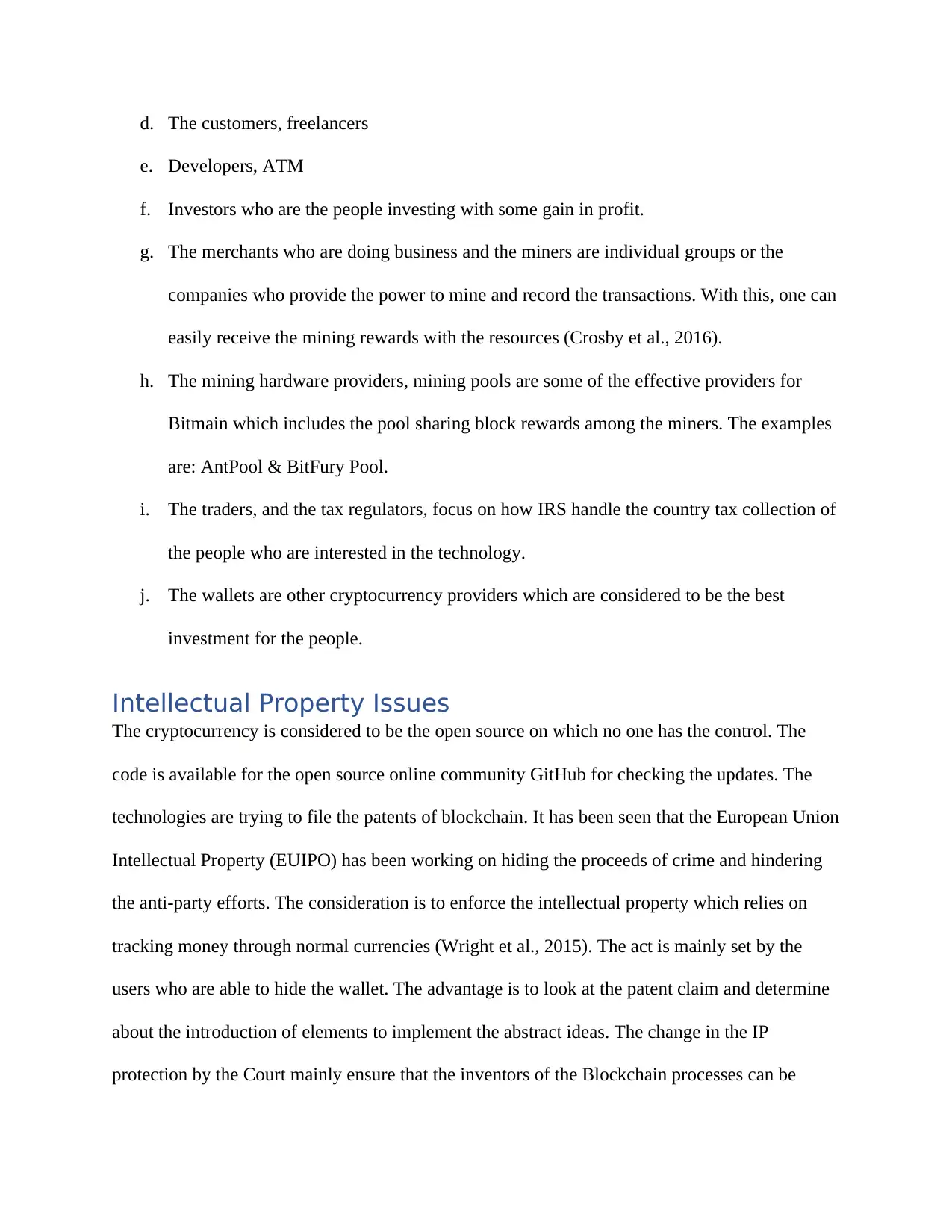
d. The customers, freelancers
e. Developers, ATM
f. Investors who are the people investing with some gain in profit.
g. The merchants who are doing business and the miners are individual groups or the
companies who provide the power to mine and record the transactions. With this, one can
easily receive the mining rewards with the resources (Crosby et al., 2016).
h. The mining hardware providers, mining pools are some of the effective providers for
Bitmain which includes the pool sharing block rewards among the miners. The examples
are: AntPool & BitFury Pool.
i. The traders, and the tax regulators, focus on how IRS handle the country tax collection of
the people who are interested in the technology.
j. The wallets are other cryptocurrency providers which are considered to be the best
investment for the people.
Intellectual Property Issues
The cryptocurrency is considered to be the open source on which no one has the control. The
code is available for the open source online community GitHub for checking the updates. The
technologies are trying to file the patents of blockchain. It has been seen that the European Union
Intellectual Property (EUIPO) has been working on hiding the proceeds of crime and hindering
the anti-party efforts. The consideration is to enforce the intellectual property which relies on
tracking money through normal currencies (Wright et al., 2015). The act is mainly set by the
users who are able to hide the wallet. The advantage is to look at the patent claim and determine
about the introduction of elements to implement the abstract ideas. The change in the IP
protection by the Court mainly ensure that the inventors of the Blockchain processes can be
e. Developers, ATM
f. Investors who are the people investing with some gain in profit.
g. The merchants who are doing business and the miners are individual groups or the
companies who provide the power to mine and record the transactions. With this, one can
easily receive the mining rewards with the resources (Crosby et al., 2016).
h. The mining hardware providers, mining pools are some of the effective providers for
Bitmain which includes the pool sharing block rewards among the miners. The examples
are: AntPool & BitFury Pool.
i. The traders, and the tax regulators, focus on how IRS handle the country tax collection of
the people who are interested in the technology.
j. The wallets are other cryptocurrency providers which are considered to be the best
investment for the people.
Intellectual Property Issues
The cryptocurrency is considered to be the open source on which no one has the control. The
code is available for the open source online community GitHub for checking the updates. The
technologies are trying to file the patents of blockchain. It has been seen that the European Union
Intellectual Property (EUIPO) has been working on hiding the proceeds of crime and hindering
the anti-party efforts. The consideration is to enforce the intellectual property which relies on
tracking money through normal currencies (Wright et al., 2015). The act is mainly set by the
users who are able to hide the wallet. The advantage is to look at the patent claim and determine
about the introduction of elements to implement the abstract ideas. The change in the IP
protection by the Court mainly ensure that the inventors of the Blockchain processes can be
Paraphrase This Document
Need a fresh take? Get an instant paraphrase of this document with our AI Paraphraser
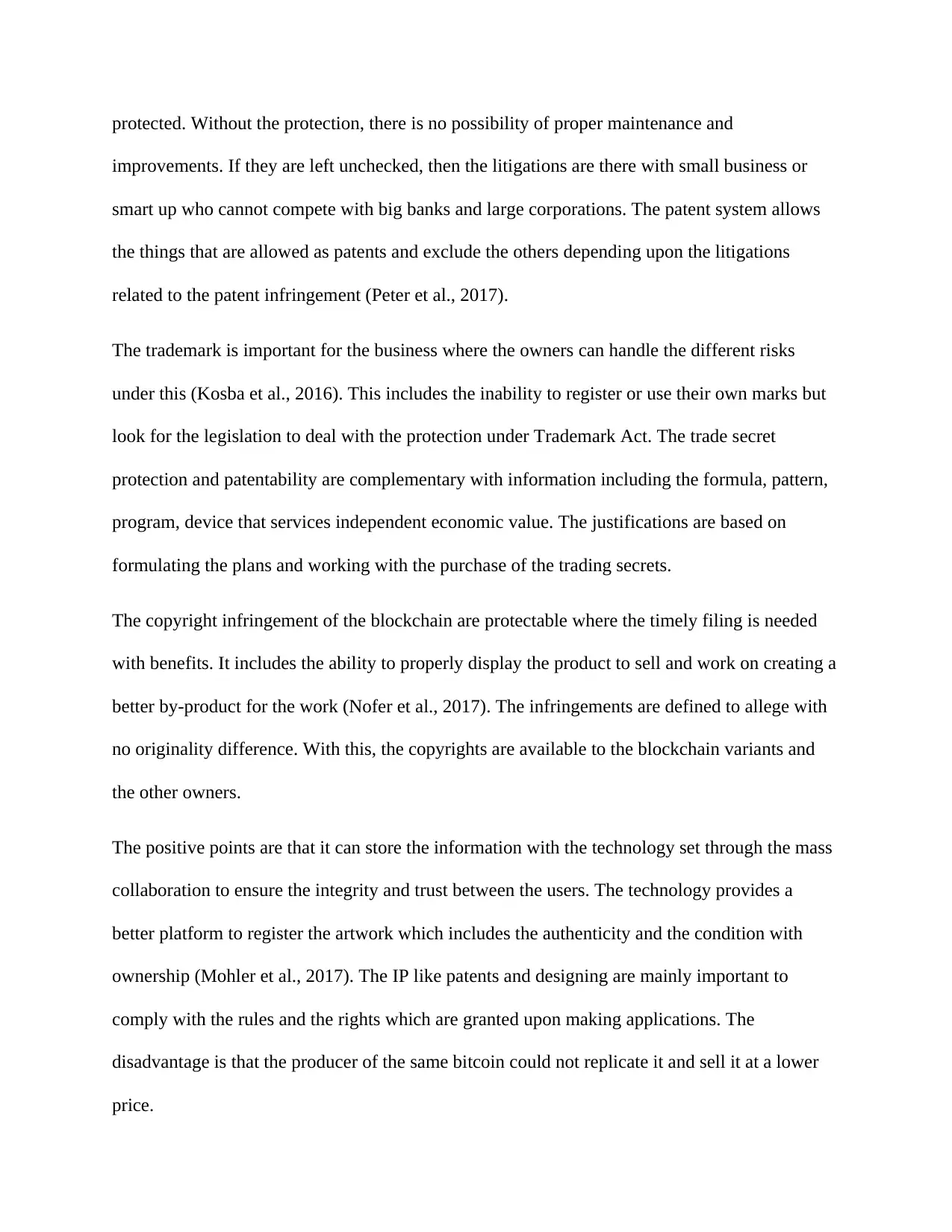
protected. Without the protection, there is no possibility of proper maintenance and
improvements. If they are left unchecked, then the litigations are there with small business or
smart up who cannot compete with big banks and large corporations. The patent system allows
the things that are allowed as patents and exclude the others depending upon the litigations
related to the patent infringement (Peter et al., 2017).
The trademark is important for the business where the owners can handle the different risks
under this (Kosba et al., 2016). This includes the inability to register or use their own marks but
look for the legislation to deal with the protection under Trademark Act. The trade secret
protection and patentability are complementary with information including the formula, pattern,
program, device that services independent economic value. The justifications are based on
formulating the plans and working with the purchase of the trading secrets.
The copyright infringement of the blockchain are protectable where the timely filing is needed
with benefits. It includes the ability to properly display the product to sell and work on creating a
better by-product for the work (Nofer et al., 2017). The infringements are defined to allege with
no originality difference. With this, the copyrights are available to the blockchain variants and
the other owners.
The positive points are that it can store the information with the technology set through the mass
collaboration to ensure the integrity and trust between the users. The technology provides a
better platform to register the artwork which includes the authenticity and the condition with
ownership (Mohler et al., 2017). The IP like patents and designing are mainly important to
comply with the rules and the rights which are granted upon making applications. The
disadvantage is that the producer of the same bitcoin could not replicate it and sell it at a lower
price.
improvements. If they are left unchecked, then the litigations are there with small business or
smart up who cannot compete with big banks and large corporations. The patent system allows
the things that are allowed as patents and exclude the others depending upon the litigations
related to the patent infringement (Peter et al., 2017).
The trademark is important for the business where the owners can handle the different risks
under this (Kosba et al., 2016). This includes the inability to register or use their own marks but
look for the legislation to deal with the protection under Trademark Act. The trade secret
protection and patentability are complementary with information including the formula, pattern,
program, device that services independent economic value. The justifications are based on
formulating the plans and working with the purchase of the trading secrets.
The copyright infringement of the blockchain are protectable where the timely filing is needed
with benefits. It includes the ability to properly display the product to sell and work on creating a
better by-product for the work (Nofer et al., 2017). The infringements are defined to allege with
no originality difference. With this, the copyrights are available to the blockchain variants and
the other owners.
The positive points are that it can store the information with the technology set through the mass
collaboration to ensure the integrity and trust between the users. The technology provides a
better platform to register the artwork which includes the authenticity and the condition with
ownership (Mohler et al., 2017). The IP like patents and designing are mainly important to
comply with the rules and the rights which are granted upon making applications. The
disadvantage is that the producer of the same bitcoin could not replicate it and sell it at a lower
price.
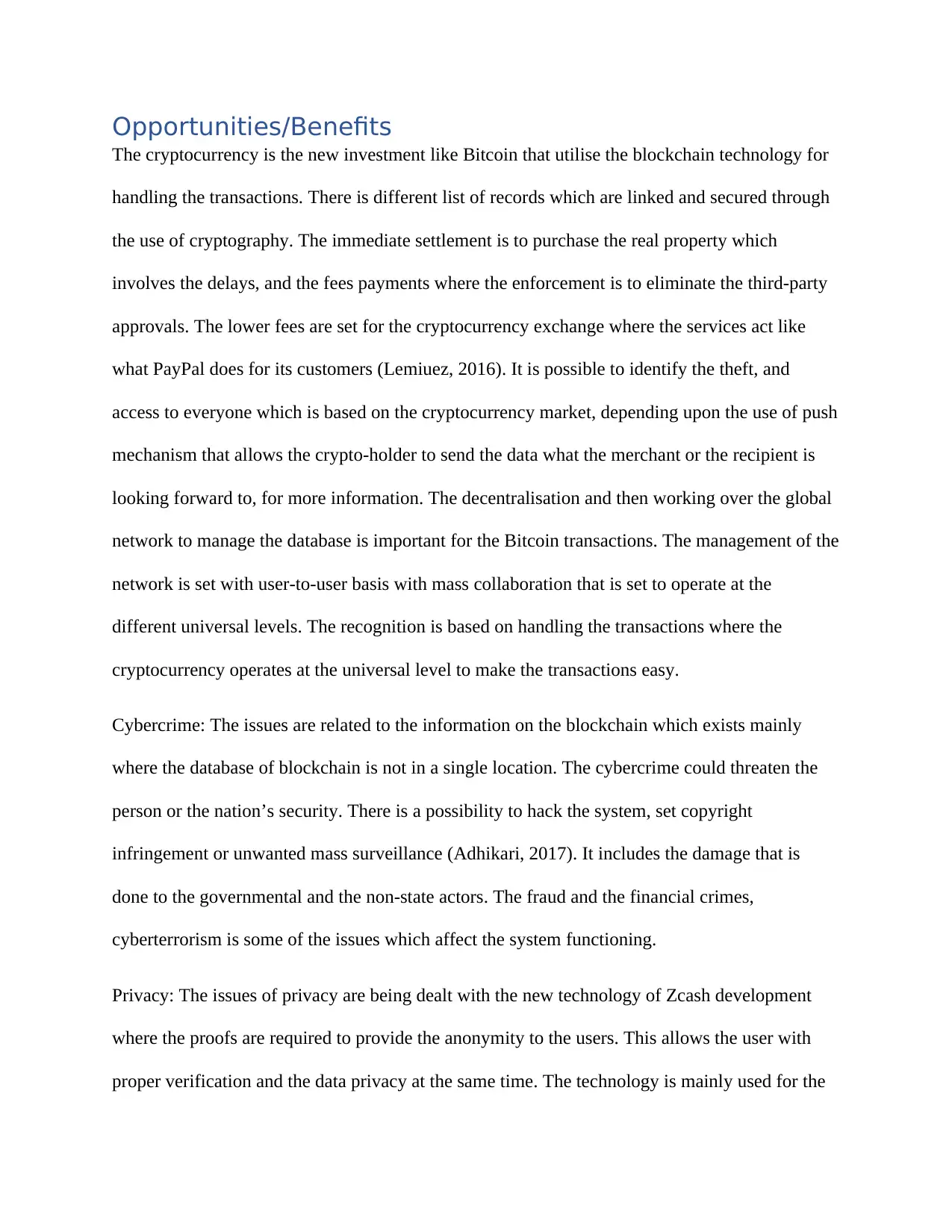
Opportunities/Benefits
The cryptocurrency is the new investment like Bitcoin that utilise the blockchain technology for
handling the transactions. There is different list of records which are linked and secured through
the use of cryptography. The immediate settlement is to purchase the real property which
involves the delays, and the fees payments where the enforcement is to eliminate the third-party
approvals. The lower fees are set for the cryptocurrency exchange where the services act like
what PayPal does for its customers (Lemiuez, 2016). It is possible to identify the theft, and
access to everyone which is based on the cryptocurrency market, depending upon the use of push
mechanism that allows the crypto-holder to send the data what the merchant or the recipient is
looking forward to, for more information. The decentralisation and then working over the global
network to manage the database is important for the Bitcoin transactions. The management of the
network is set with user-to-user basis with mass collaboration that is set to operate at the
different universal levels. The recognition is based on handling the transactions where the
cryptocurrency operates at the universal level to make the transactions easy.
Cybercrime: The issues are related to the information on the blockchain which exists mainly
where the database of blockchain is not in a single location. The cybercrime could threaten the
person or the nation’s security. There is a possibility to hack the system, set copyright
infringement or unwanted mass surveillance (Adhikari, 2017). It includes the damage that is
done to the governmental and the non-state actors. The fraud and the financial crimes,
cyberterrorism is some of the issues which affect the system functioning.
Privacy: The issues of privacy are being dealt with the new technology of Zcash development
where the proofs are required to provide the anonymity to the users. This allows the user with
proper verification and the data privacy at the same time. The technology is mainly used for the
The cryptocurrency is the new investment like Bitcoin that utilise the blockchain technology for
handling the transactions. There is different list of records which are linked and secured through
the use of cryptography. The immediate settlement is to purchase the real property which
involves the delays, and the fees payments where the enforcement is to eliminate the third-party
approvals. The lower fees are set for the cryptocurrency exchange where the services act like
what PayPal does for its customers (Lemiuez, 2016). It is possible to identify the theft, and
access to everyone which is based on the cryptocurrency market, depending upon the use of push
mechanism that allows the crypto-holder to send the data what the merchant or the recipient is
looking forward to, for more information. The decentralisation and then working over the global
network to manage the database is important for the Bitcoin transactions. The management of the
network is set with user-to-user basis with mass collaboration that is set to operate at the
different universal levels. The recognition is based on handling the transactions where the
cryptocurrency operates at the universal level to make the transactions easy.
Cybercrime: The issues are related to the information on the blockchain which exists mainly
where the database of blockchain is not in a single location. The cybercrime could threaten the
person or the nation’s security. There is a possibility to hack the system, set copyright
infringement or unwanted mass surveillance (Adhikari, 2017). It includes the damage that is
done to the governmental and the non-state actors. The fraud and the financial crimes,
cyberterrorism is some of the issues which affect the system functioning.
Privacy: The issues of privacy are being dealt with the new technology of Zcash development
where the proofs are required to provide the anonymity to the users. This allows the user with
proper verification and the data privacy at the same time. The technology is mainly used for the
⊘ This is a preview!⊘
Do you want full access?
Subscribe today to unlock all pages.

Trusted by 1+ million students worldwide
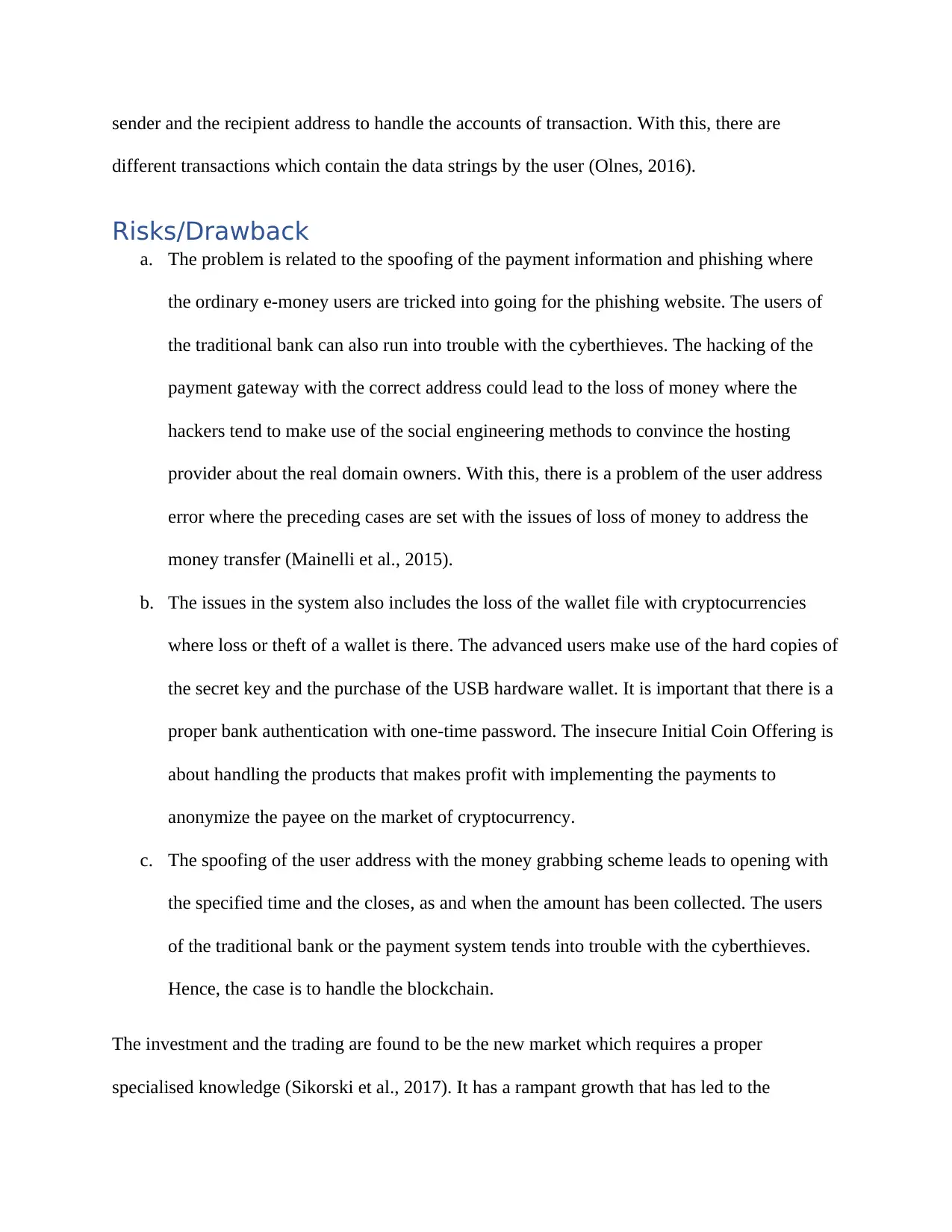
sender and the recipient address to handle the accounts of transaction. With this, there are
different transactions which contain the data strings by the user (Olnes, 2016).
Risks/Drawback
a. The problem is related to the spoofing of the payment information and phishing where
the ordinary e-money users are tricked into going for the phishing website. The users of
the traditional bank can also run into trouble with the cyberthieves. The hacking of the
payment gateway with the correct address could lead to the loss of money where the
hackers tend to make use of the social engineering methods to convince the hosting
provider about the real domain owners. With this, there is a problem of the user address
error where the preceding cases are set with the issues of loss of money to address the
money transfer (Mainelli et al., 2015).
b. The issues in the system also includes the loss of the wallet file with cryptocurrencies
where loss or theft of a wallet is there. The advanced users make use of the hard copies of
the secret key and the purchase of the USB hardware wallet. It is important that there is a
proper bank authentication with one-time password. The insecure Initial Coin Offering is
about handling the products that makes profit with implementing the payments to
anonymize the payee on the market of cryptocurrency.
c. The spoofing of the user address with the money grabbing scheme leads to opening with
the specified time and the closes, as and when the amount has been collected. The users
of the traditional bank or the payment system tends into trouble with the cyberthieves.
Hence, the case is to handle the blockchain.
The investment and the trading are found to be the new market which requires a proper
specialised knowledge (Sikorski et al., 2017). It has a rampant growth that has led to the
different transactions which contain the data strings by the user (Olnes, 2016).
Risks/Drawback
a. The problem is related to the spoofing of the payment information and phishing where
the ordinary e-money users are tricked into going for the phishing website. The users of
the traditional bank can also run into trouble with the cyberthieves. The hacking of the
payment gateway with the correct address could lead to the loss of money where the
hackers tend to make use of the social engineering methods to convince the hosting
provider about the real domain owners. With this, there is a problem of the user address
error where the preceding cases are set with the issues of loss of money to address the
money transfer (Mainelli et al., 2015).
b. The issues in the system also includes the loss of the wallet file with cryptocurrencies
where loss or theft of a wallet is there. The advanced users make use of the hard copies of
the secret key and the purchase of the USB hardware wallet. It is important that there is a
proper bank authentication with one-time password. The insecure Initial Coin Offering is
about handling the products that makes profit with implementing the payments to
anonymize the payee on the market of cryptocurrency.
c. The spoofing of the user address with the money grabbing scheme leads to opening with
the specified time and the closes, as and when the amount has been collected. The users
of the traditional bank or the payment system tends into trouble with the cyberthieves.
Hence, the case is to handle the blockchain.
The investment and the trading are found to be the new market which requires a proper
specialised knowledge (Sikorski et al., 2017). It has a rampant growth that has led to the
Paraphrase This Document
Need a fresh take? Get an instant paraphrase of this document with our AI Paraphraser
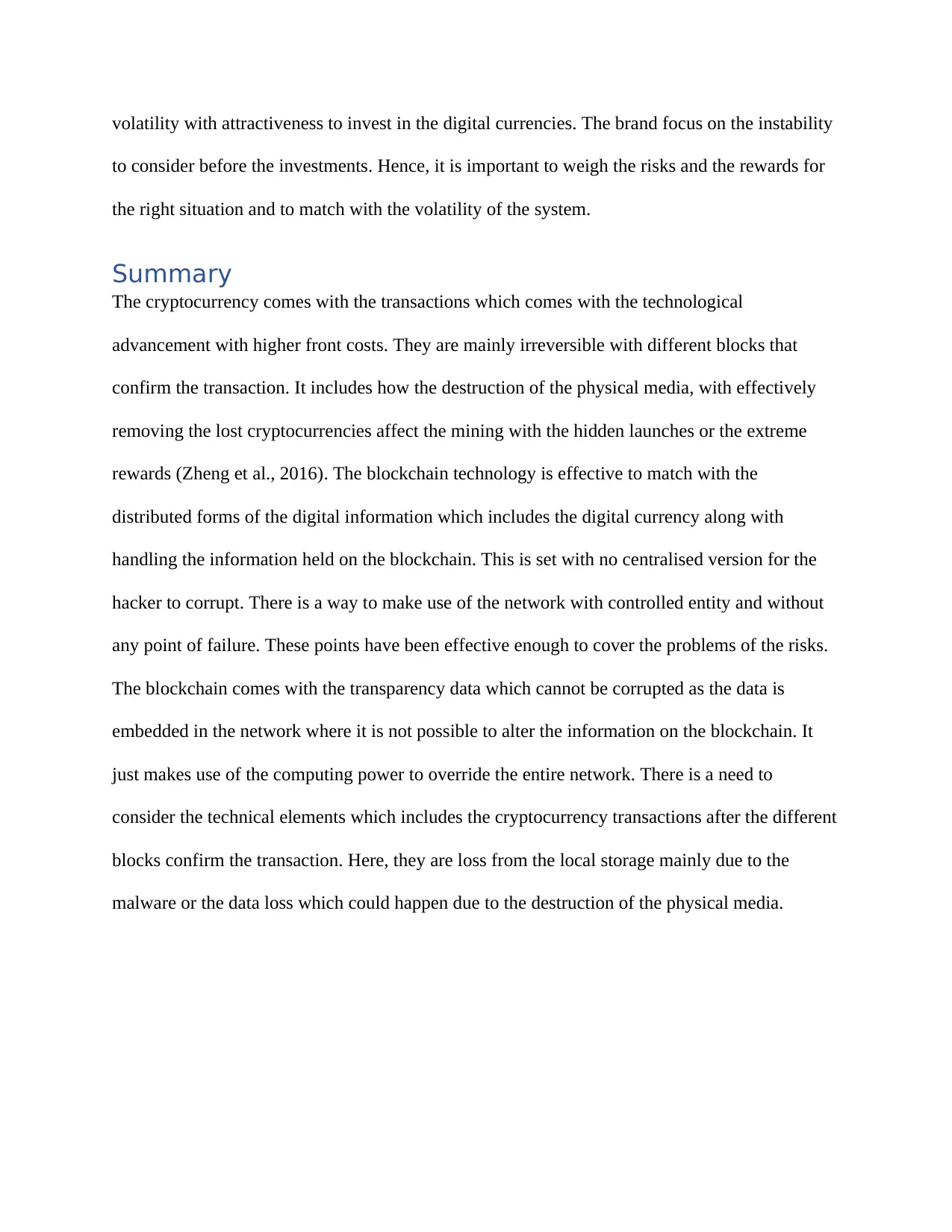
volatility with attractiveness to invest in the digital currencies. The brand focus on the instability
to consider before the investments. Hence, it is important to weigh the risks and the rewards for
the right situation and to match with the volatility of the system.
Summary
The cryptocurrency comes with the transactions which comes with the technological
advancement with higher front costs. They are mainly irreversible with different blocks that
confirm the transaction. It includes how the destruction of the physical media, with effectively
removing the lost cryptocurrencies affect the mining with the hidden launches or the extreme
rewards (Zheng et al., 2016). The blockchain technology is effective to match with the
distributed forms of the digital information which includes the digital currency along with
handling the information held on the blockchain. This is set with no centralised version for the
hacker to corrupt. There is a way to make use of the network with controlled entity and without
any point of failure. These points have been effective enough to cover the problems of the risks.
The blockchain comes with the transparency data which cannot be corrupted as the data is
embedded in the network where it is not possible to alter the information on the blockchain. It
just makes use of the computing power to override the entire network. There is a need to
consider the technical elements which includes the cryptocurrency transactions after the different
blocks confirm the transaction. Here, they are loss from the local storage mainly due to the
malware or the data loss which could happen due to the destruction of the physical media.
to consider before the investments. Hence, it is important to weigh the risks and the rewards for
the right situation and to match with the volatility of the system.
Summary
The cryptocurrency comes with the transactions which comes with the technological
advancement with higher front costs. They are mainly irreversible with different blocks that
confirm the transaction. It includes how the destruction of the physical media, with effectively
removing the lost cryptocurrencies affect the mining with the hidden launches or the extreme
rewards (Zheng et al., 2016). The blockchain technology is effective to match with the
distributed forms of the digital information which includes the digital currency along with
handling the information held on the blockchain. This is set with no centralised version for the
hacker to corrupt. There is a way to make use of the network with controlled entity and without
any point of failure. These points have been effective enough to cover the problems of the risks.
The blockchain comes with the transparency data which cannot be corrupted as the data is
embedded in the network where it is not possible to alter the information on the blockchain. It
just makes use of the computing power to override the entire network. There is a need to
consider the technical elements which includes the cryptocurrency transactions after the different
blocks confirm the transaction. Here, they are loss from the local storage mainly due to the
malware or the data loss which could happen due to the destruction of the physical media.
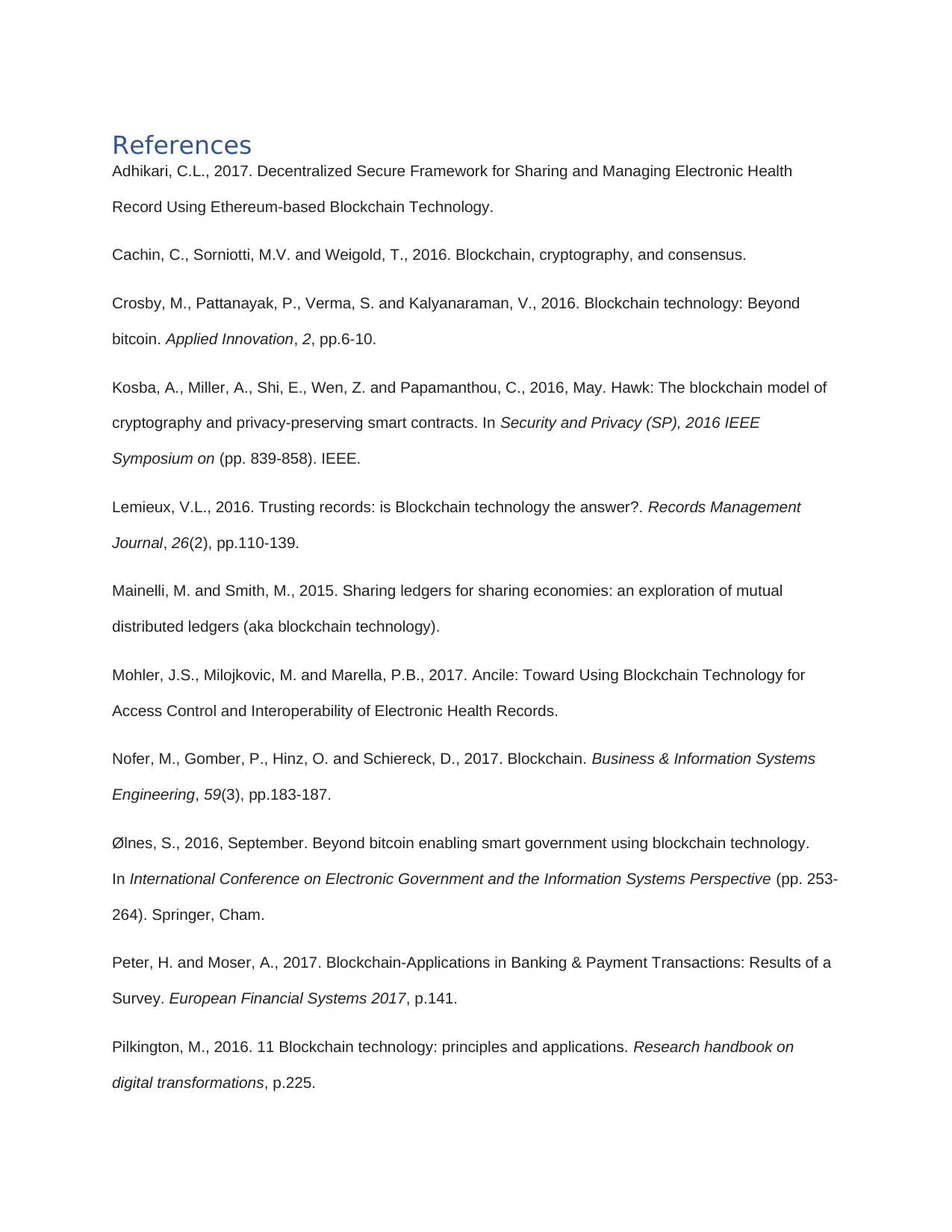
References
Adhikari, C.L., 2017. Decentralized Secure Framework for Sharing and Managing Electronic Health
Record Using Ethereum-based Blockchain Technology.
Cachin, C., Sorniotti, M.V. and Weigold, T., 2016. Blockchain, cryptography, and consensus.
Crosby, M., Pattanayak, P., Verma, S. and Kalyanaraman, V., 2016. Blockchain technology: Beyond
bitcoin. Applied Innovation, 2, pp.6-10.
Kosba, A., Miller, A., Shi, E., Wen, Z. and Papamanthou, C., 2016, May. Hawk: The blockchain model of
cryptography and privacy-preserving smart contracts. In Security and Privacy (SP), 2016 IEEE
Symposium on (pp. 839-858). IEEE.
Lemieux, V.L., 2016. Trusting records: is Blockchain technology the answer?. Records Management
Journal, 26(2), pp.110-139.
Mainelli, M. and Smith, M., 2015. Sharing ledgers for sharing economies: an exploration of mutual
distributed ledgers (aka blockchain technology).
Mohler, J.S., Milojkovic, M. and Marella, P.B., 2017. Ancile: Toward Using Blockchain Technology for
Access Control and Interoperability of Electronic Health Records.
Nofer, M., Gomber, P., Hinz, O. and Schiereck, D., 2017. Blockchain. Business & Information Systems
Engineering, 59(3), pp.183-187.
Ølnes, S., 2016, September. Beyond bitcoin enabling smart government using blockchain technology.
In International Conference on Electronic Government and the Information Systems Perspective (pp. 253-
264). Springer, Cham.
Peter, H. and Moser, A., 2017. Blockchain-Applications in Banking & Payment Transactions: Results of a
Survey. European Financial Systems 2017, p.141.
Pilkington, M., 2016. 11 Blockchain technology: principles and applications. Research handbook on
digital transformations, p.225.
Adhikari, C.L., 2017. Decentralized Secure Framework for Sharing and Managing Electronic Health
Record Using Ethereum-based Blockchain Technology.
Cachin, C., Sorniotti, M.V. and Weigold, T., 2016. Blockchain, cryptography, and consensus.
Crosby, M., Pattanayak, P., Verma, S. and Kalyanaraman, V., 2016. Blockchain technology: Beyond
bitcoin. Applied Innovation, 2, pp.6-10.
Kosba, A., Miller, A., Shi, E., Wen, Z. and Papamanthou, C., 2016, May. Hawk: The blockchain model of
cryptography and privacy-preserving smart contracts. In Security and Privacy (SP), 2016 IEEE
Symposium on (pp. 839-858). IEEE.
Lemieux, V.L., 2016. Trusting records: is Blockchain technology the answer?. Records Management
Journal, 26(2), pp.110-139.
Mainelli, M. and Smith, M., 2015. Sharing ledgers for sharing economies: an exploration of mutual
distributed ledgers (aka blockchain technology).
Mohler, J.S., Milojkovic, M. and Marella, P.B., 2017. Ancile: Toward Using Blockchain Technology for
Access Control and Interoperability of Electronic Health Records.
Nofer, M., Gomber, P., Hinz, O. and Schiereck, D., 2017. Blockchain. Business & Information Systems
Engineering, 59(3), pp.183-187.
Ølnes, S., 2016, September. Beyond bitcoin enabling smart government using blockchain technology.
In International Conference on Electronic Government and the Information Systems Perspective (pp. 253-
264). Springer, Cham.
Peter, H. and Moser, A., 2017. Blockchain-Applications in Banking & Payment Transactions: Results of a
Survey. European Financial Systems 2017, p.141.
Pilkington, M., 2016. 11 Blockchain technology: principles and applications. Research handbook on
digital transformations, p.225.
⊘ This is a preview!⊘
Do you want full access?
Subscribe today to unlock all pages.

Trusted by 1+ million students worldwide
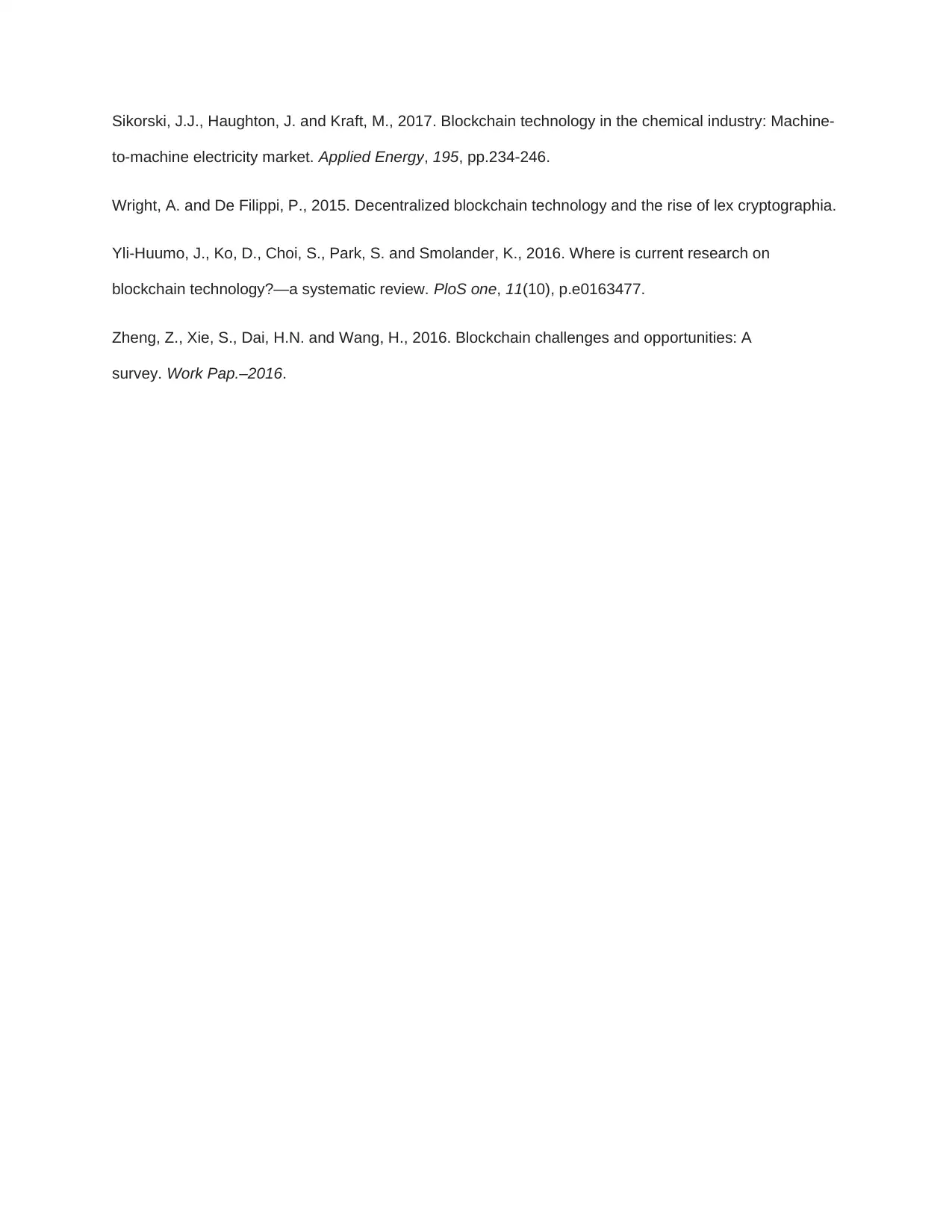
Sikorski, J.J., Haughton, J. and Kraft, M., 2017. Blockchain technology in the chemical industry: Machine-
to-machine electricity market. Applied Energy, 195, pp.234-246.
Wright, A. and De Filippi, P., 2015. Decentralized blockchain technology and the rise of lex cryptographia.
Yli-Huumo, J., Ko, D., Choi, S., Park, S. and Smolander, K., 2016. Where is current research on
blockchain technology?—a systematic review. PloS one, 11(10), p.e0163477.
Zheng, Z., Xie, S., Dai, H.N. and Wang, H., 2016. Blockchain challenges and opportunities: A
survey. Work Pap.–2016.
to-machine electricity market. Applied Energy, 195, pp.234-246.
Wright, A. and De Filippi, P., 2015. Decentralized blockchain technology and the rise of lex cryptographia.
Yli-Huumo, J., Ko, D., Choi, S., Park, S. and Smolander, K., 2016. Where is current research on
blockchain technology?—a systematic review. PloS one, 11(10), p.e0163477.
Zheng, Z., Xie, S., Dai, H.N. and Wang, H., 2016. Blockchain challenges and opportunities: A
survey. Work Pap.–2016.
1 out of 10
Related Documents
Your All-in-One AI-Powered Toolkit for Academic Success.
+13062052269
info@desklib.com
Available 24*7 on WhatsApp / Email
![[object Object]](/_next/static/media/star-bottom.7253800d.svg)
Unlock your academic potential
Copyright © 2020–2025 A2Z Services. All Rights Reserved. Developed and managed by ZUCOL.





